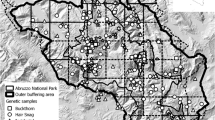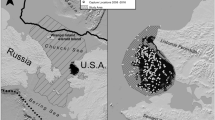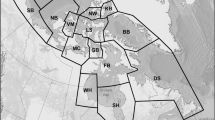Abstract
Current management of the grizzly bear (Ursus arctos) population in Yellowstone National Park and surrounding areas requires annual estimation of the number of adult female bears with cubs-of-the-year. We examined the performance of nine estimators of population size via simulation. Data were simulated using two methods for different combinations of population size, sample size, and coefficient of variation of individual sighting probabilities. We show that the coefficient of variation does not, by itself, adequately describe the effects of capture heterogeneity, because two different distributions of capture probabilities can have the same coefficient of variation. All estimators produced biased estimates of population size with bias decreasing as effort in creased. Based on the simulation results we recommend the Chao estimator for model M h be used to estimate the number of the female bears with cubs of the year; however, the estimator of Chao and Shen may also be useful depending on the goals of the research.
Similar content being viewed by others
References
Ashbridge, J., and Goudie, I. B. J. (2000), “Coverage-Adjusted Estimators for Mark-Recapture in Heterogeneous Populations,” Communications in Statistics B—Simulation and Computation, 29, 1215–1237.
Boyce, M. S., MacKenzie, D. I., Manly, B. F. J., Haroldson, M. A., and Moody, D. (2001), “Negative Binomial Models for Abundance Estimation of Multiple Closed Populations,” Journal of Wildlife Management, 65, 498–509.
Burnham, K. P., and Anderson, D. R. (2002), Model Selection and Multimodel Inference: A Practical Information-Theoretic Approach (2nd ed.), New York: Springer-Velag.
Burnham, K. P., and Overton, W. S. (1978), “Robust Estimation of Population Size when Capture Probbabilities Vary Among Animals,” Ecology, 60, 927–936.
Chao, A. (1984), “Nonparametric Estimation of the Number of Classes in a Population,” Scandinavian Journal of Statistics, 11, 265–270.
— (1987), “Estimating the Population Size for Capture-Recapture Data with Unequal Catchability,” Biometrics, 43, 783–791.
— (1989), “Estimating Populationg Size for Sparse Data in Capture-Recapture Experiments,” Biometrics, 45, 427–438.
Chao, A., and Lee, S.-M. (1992), “Estimating the Number of Classes via Sample Coverage,” Journal of the American Statistical Association, 87, 210–217.
Chao, A., and Shen, T.-J. (2004), “Nonparametric Prediction in Species Sampling,” Journal of Agricultural, Biological, and Environmental Statistics, 9, 253–269.
Chao, A., and Shen, T.-J. (2006), User’s Guide for Program SPADE (Species Prediction and Diversity Estimation), (http://chao.stat.nthu.edu.tw/SPADE_UserGuide(11_12_2006).pdf).
Darroch, J. N., and Ratcliff, D. (1980), “A Note on Capture-Recapture Estimation,” Biometrics, 36, 149–153.
Dorazio, R. M., and Royle, J. A. (2003), “Mixture Models for Estimating the Size of a Closed Population when Capture Rates Vary Among Individuals,” Biometrics, 59, 351–364.
— (2005), “The Performance of Mixture Models in Heterogeneous Closed Population Capture-Recapture,” (Reply), Biometrics, 61, 874–876.
Green, G. I., Mattson, D. J., and Peek, J. M. (1997), “Spring Feeding on Ungulate Carcasses by Grizzly Bears in Yellowstone National Park,” Journal of Wildlife Management, 61, 1040–1055.
Harting, Jr., A. L. (1985), “Relationships Between Activity Patterns and Foraging Strategies of Yellow stone Grizzly Bears,” unpublished M.S. Thesis, Montana State University, Bozeman, Montana.
Haroldson, M. A. (2005), “Unduplicated Females” in Yellowstone Grizzly Bear Investigations, Annual Report of the Interagency Grizzly Bear Study Team, 2004, eds. C. C. Schwartz and M. A. Haroldson. U.S. Geological Survey, Bozeman, Montana, (http://www.nrmsc.usgs.gov/products/IGBST/2004report.pdf).
Keating, K. A., Schwartz, C. C., Haroldson, M. A., and Moody, D. (2002), “Estimating Numbers of Females with Cubs-of-the-Year in the Yellowstone Grizzly Bear Population,” Ursus, 13, 161–174.
Knight, R. R., Blanchard, B. M., and Eberhardt, L. L. (1995), “Appraising Status of the Yellowstone Grizzly Bear Population by Counting Females with Cubs-of-the-Year,” Wildlife Society Bulletin, 23, 245–248.
Lee, S.-M., and Chao, A. (1994), “Estimating Population Size Via Sample Coverage for Closed Capture-Recapture Models,” Biometrics, 50, 88–97.
Link, W. A. (2003), “Nonidentifiability of Population Size from Capture-Recapture Data with Heterogeneous Detection Probabilities,” Biometrics, 59, 1123–1130.
Mattson, D. J. (1997), “Use of Ungulates by Yellowstone Grizzly Bears,” Biological Conservation, 81, 161–177.
Mattson, D. J., Blanchard, B. M., and Knight, R. R. (1991a), “Food Habits of Yellowstone Grizzly Bears, 1977–1987,” Canadian Journal of Zoology, 69, 1619–1629.
— (1991b), “Bear Feeding Activity at Alpine Insect Aggregation Sites in the Yellowstone Ecosystem,” Canadian Journal of Zoology, 69, 2430–2435.
MacKenzie, D. I., Nichols, J. D., Sutton, N., Kawanishi, K., and Bailey, L. L. (2005), “Improving Inferences in Population Studies of Rare Species that are Detected Imperfectly,” Ecology, 86, 1101–1113.
Norris, J. L., and Pollock, K. H. (1998), “Non-parametric MLE for Poisson Species Abundance Models Allowing for Heterogeneity Between Species,” Environmental and Ecological Statistics, 5, 391–402.
Otis, D. L., Burnham, K. P., White, G. C., and Anderson, D. R. (1978), “Statistical Inference from Capture Data on Closed Animal Populations,” Wildlife Monographs, 62, 1–135.
Pledger, S. (2000), “Unified Maximum Likelihood Estimates for Closed Capture-Recapture Models using Mixtures,” Biometrics, 56, 434–442.
— (2005), “The Performance of Mixture Models in Heterogeneous Closed Population Capture-Recapture,” Biometrics, 61, 868–873.
SAS Institute (2003), Online documentation for SAS/Base and SAS/OR, version 9.1, Cary, North Carolina: SAS Institute.
Schleyer, B. (1983) “Activity Patterns of Grizzly Bears in the Yellowstone Ecosystem and their Reproductive Behavior, Predation and the Use of Carrion,” unpublished M.S. Thesis, Montana State University, Bozeman, Montana.
Schwartz, C. C. (1999), “Evaluation of a Capture-Mark-Recapture Estimator to Determine Grizzly Bear numbers and Density in the Greater Yellowstone Area,” in Yellowstone Grizzly Bear Investigations: Annual Report of the Interagency Grizzly Bear Study Team, 1998, eds. C. C. Schwartz M. A. Haroldson, U.S. Geological Survey, Bozeman, Montana. Available online at http://www.nrmsc.usgs.gov/products/IGBST/1998report.pdf.
Seber, G. A. F. (1982), “The Estimation of Animal Abundance and Related Parameters (2nd ed.), New York: Macmillan Press.
U.S. Fish and Wildlife Service (1993), Grizzly Bear Recovery Plan, Missoula, Montana, USA. Available online at http://ecos.fws.gov/docs/recovery plans/2006/060224.pdf.
West, K. (2005a), “Observation Flights,” Yellowstone Grizzly Bear Investigations: Annual Report of the Interagency Grizzly Bear Study Team, 2004, eds. C. C. Schwartz, M. A. Haroldson, and K. West, U.S. Geological Survey, Bozeman, Montana. Available online at http://www.nrmsc.usgs.gov/products/IGBST/2004report.pdf.
— (2005b), “Telemetry Relocation Flights,” in Yellowstone Grizzly Bear Investigations: Annual Report of the Interagency Grizzly Bear Study Team, 2004, eds. C. C. Schwartz, M. A. Haroldson, and K. West, U.S. Geological Survey, Bozeman, Montana. Available online at http://www.nrmsc.usgs.gov/products/IGBST/ 2004report.pdf.
White, G. C. (2005), “Correcting Wildlife Counts with Detection Probabilities,” Wildlife Research, 32, 211–216.
Wilson, R. M., and Collins, M. F. (1992), “Capture-Recapture Estimation with Samples of Size One using Frequency Data,” Biometrika, 79, 543–553.
Author information
Authors and Affiliations
Corresponding author
Rights and permissions
About this article
Cite this article
Cherry, S., White, G.C., Keating, K.A. et al. Evaluating estimators of the numbers of females with cubs-of-the-year in the yellowstone grizzly bear population. JABES 12, 195 (2007). https://doi.org/10.1198/108571107X198804
Received:
Revised:
DOI: https://doi.org/10.1198/108571107X198804




